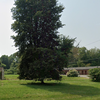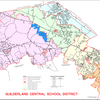Ringmaster: Bielik’s show is about preserving an historic way of marbling paper
John Charles Bielik is a teacher, a designer, an historian, and a preservationist.
He makes marbled paper — the sort of colorful patterned paper that you see in centuries-old books — the traditional way.
“It is a profession and I am a professional,” Bielik says in this week’s Enterprise podcast.
He is also a performer, an entertainer.
“I’m an act,” he says.
Bielik will be, for the first time, at the Altamont Fair this week, making marbled paper.
“The stilt walkers and the jugglers and the people that are at these fairs, they hang around me because they think I’m one of them,” he said. “I guess I am …
“I’ve gotten to know many of these people through the years … We’re in a circus. And I’ve got my own little tent, and that’s my circus. And I’m the ringmaster.”
Bielik started making marbled paper almost three decades ago, in 1994, in Missouri where he lives.
“It was a way to teach children in a literacy program that I was part of in Saint Louis …,” he said. “Some of them came from pretty rough backgrounds and we bonded with them quite well … And they loved the marbling, of course.”
The kids, he said, “liked the fact that they could throw paint and it would look good every time.”
Later, Bielik said, “I went into the real deep city in Charleston, South Carolina … and those kids had never seen anything like this at all, and they were just blown away.
“And so I kept seeing that reaction wherever I go. And it was no different from the adults. They would get all excited and jump up and down and just — I couldn’t stop … We wouldn’t stop for lunch during classes because they just couldn’t stop marbling.”
As a young child, Bielik had seen marbled paper in books at the big public library in St. Louis.
“There’s something about my personality that I’m drawn to old things,” he says.
His mother was a genealogist, he said, “and history was always kind of floating around in our house. We had antiques and we always went to look at the old books.”
When he studied in a graduate program for graphic design at Virginia Commonwealth University in Richmond, Virginia, Bielik focused on print media and developed a thesis on linear and non-linear thinking, on “how the eye and the mind work together to get information and make communication out of it.”
Film, he explains, is a linear medium, because it begins at a set place, travels through time, and ends. Posters and billboards, on the other hand, are non-linear.
“There’s no start and stop on a poster,” said Bielik. “It’s just all at once.” He described how graphic designers and artists guide the viewer’s eyes, through images and sometimes type, to communicate.
Talk is often linear “it’s all in a line,” he said — but you “can take words out of context and they mean something completely different.” His goal was to “put images in context of each other in a certain order to get certain information across.
“So it’s kind of like hieroglyphs …. They don’t mean anything to us unless we really study them. But images can become very accurate modes of communication, even though they’re not verbal. Anybody, no matter what language you have, you have the potential to speak to somebody,” he said of using images.
In his graduate work, Bielik put together books of his own making, for example, one on a tornado that included laundry blowing on a clothesline and a landscape with clouds that communicated the feeling of a storm.
For that, he wanted marbled paper “that had a lot of swirls in it, that was kind of dark, and that was just a tiny bit of the information that might help somebody understand the feeling or the message of the book … There were no words in the book.”
His interest in marbled paper led Bielik to master paper marbler Curtis Findlay. Bielik learned about the different periods in the history of marbling in places around the world.
While alum (potassium aluminum sulfate) is used today to get dye or pigment to stick to fabrics or paper, “alum eats up paper and that’s the main reason why a lot of our papers in our old books are just deteriorating,” says Bielik.
So Bielik researched pigments that were used in the 1600s and 1700s. “It took about six to eight months of grinding pigments and looking all over the world, literally, for pigments that might work,” he said.
“And you know what? They worked to my amazement,” he said of the pigments he made himself based on his research.
He used to grind pigments — yellow ochre, for example — by hand but then he found that “a blender worked fine.”
A friend of his, a glassblower, made “a big teardrop thing with a flat surface so I would grind the pigments in water and break them apart and get them as fine as possible,” he said.
In old paintings, you can see artists grinding pigment, Bielik says, noting there is a scene in the movie, “Girl with a Pearl Earring,” taking off from Johannes Vermeer’s painting of the same name, where she is “grinding pigments the same way that I do.”
One important difference, Bielik notes, is he uses water, rather than oil, creating a gouache.
Traveling to fairs, like Altamont’s, Bielik says “sort of sustains me financially but it definitely sustains me emotionally and spiritually.”
“I like to teach and I like to preserve things,” he says, like the marbling trade.
He began demonstrating his trade at rendezvous events, historical re-enactments that are popular in the Midwest. Wearing period costumes, re-enactors demonstrate trades like blacksmithing, chair-making, weaving, or spinning.
Many of the re-enactors, including Bielik, have been featured in the backgrounds of movies because their look is so authentic, he said.
Bielik has trousers made by Amish women in Ohio and shirts made by Sycamore Spring Clothier also in Ohio. And he has made himself fingerless gloves, and aprons copied from old paintings.
He plies his trade in a tent on fairgrounds. “I don’t have any plastic,” said Bielik of his tent and its tools. “You walk in there and it’s a time capsule and that’s entertainment.”
Sometimes he works quietly as onlookers observe his marbling. Other times, he explains what he is doing.
“Children just go crazy about it,” he said. “It’s great that I can give them a little joy during the day and yet still insert some history and learning there.”
At center stage in his tent is a wooden box filled with about two inches of water. “It all happens in the box,” Bielik said.
The water has carrageenan in it, extracted from seaweed in the British Isles, which acts as a gelling agent.
He then throws water-based paint on the carrageenan-thickened water in his box. “The two waters don’t mix because of the secret sauce,” he said.
Bielik explained that the central ingredient in the secret sauce is liver bile, which he gets from “a buddy in Sheboygan, Wisconsin” who slaughters cows.
The bile is fatty and binds with the pigment and also bonds with the paper, he said.
Bielik then uses a comb with metal teeth, running it through the mixture to create a pattern. “Then I’ll lay paper on top of that very gently. I’ll pull it up — and it’s done.”
He hangs the finished papers above him and behind him, each one unique.
“You’ll get to see the history of the day’s work,” he said. “I always call it the day’s catch.”
Bielik concluded, “I just want everybody to know that there are a few of us out there that are preserving history, whether it be restoring automobiles, printing presses, old houses, or a trade like marbled paper.
“And it’s not necessarily the paper but it’s the process, the tools and material — that’s what I’m preserving. It’s the act of marbling as it was done… So I’m a preservationist.
“That’s what I want everybody to see when they come there,” he said of his time at the Altamont Fair. “It’s just like a little history happening.”



